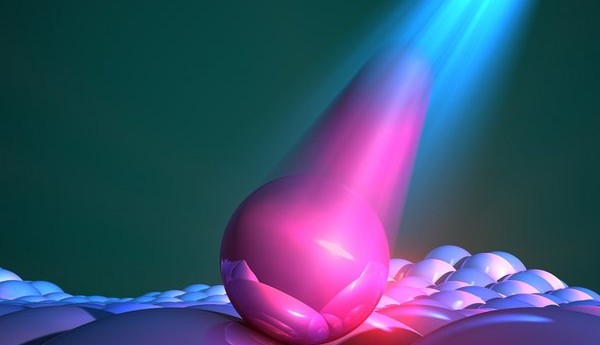New Measurement Technique: Cheap, Almost Perfect Quantum Dots
April 08, 2019
on
on

Modern electronics in, for example, solar panels, camera sensors and medical imaging equipment often contains semiconductor material with a continuous crystal structure, a mono crystal. Unfortunately these mono-crystalline materials are very expensive. Small nano-crystals, so-called quantum dots, are much easier to make and therefore cheaper. They have therefore already made their debut in consumer electronics, for example in quantum-dot TVs. A disadvantage was that their quality was difficult to measure. Researchers from Stanford University, the University of Berkeley and the Eindhoven University of Technology have, however, developed a measurement technique that works better. Using this they have demonstrated that the quantum dots work very well. The results of their research have been published in Science.
The researchers have mainly looked at the luminescence efficiency of quantum dots: the measure of the amount of light that they re-emit from that what they have absorbed. This is an important indicator for the quality of semiconductors. That quantum dots could score very high in this area was already made clear in earlier research. But this is the first measurement technique that can convincingly demonstrate that they can compete with mono-crystals.
But there are also disadvantages. Quantum dots are so small that billions are required to do the job a of a perfect single crystal. And the more quantum dots you make, the greater the likelihood that something goes wrong, with detrimental consequences for their performance.
Existing measurement techniques already indicated that semiconductors from quantum dots were potentially more efficient, with a luminescence efficiency of more than 99 percent. But researchers needed a new technique to measure how efficient these nano crystals actually are.
Contrary to concerns, the quantum dots appear so be surprisingly robust. Furthermore, this measurement technique can also compare different quantum structures for the first time.
Source: Technical University Eindhoven
Near-perfect
Using this new technique it is possible to make cheap and near-perfect semiconductors, that are just as good as the much more expensive alternatives.The researchers have mainly looked at the luminescence efficiency of quantum dots: the measure of the amount of light that they re-emit from that what they have absorbed. This is an important indicator for the quality of semiconductors. That quantum dots could score very high in this area was already made clear in earlier research. But this is the first measurement technique that can convincingly demonstrate that they can compete with mono-crystals.
Advantages and disadvantages
Quantum dots are very easy to manipulate. If you change their size, you also change to wavelength of the radiated light. This is a useful property for applications that use colour, such as TVs, computers and markers for biological indicators. Because of their small size they are also relatively cheap to make.But there are also disadvantages. Quantum dots are so small that billions are required to do the job a of a perfect single crystal. And the more quantum dots you make, the greater the likelihood that something goes wrong, with detrimental consequences for their performance.
Existing measurement techniques already indicated that semiconductors from quantum dots were potentially more efficient, with a luminescence efficiency of more than 99 percent. But researchers needed a new technique to measure how efficient these nano crystals actually are.
Nearly one hundred percent
The researchers used a technique that, instead of measuring the light emission, measures the heat produced by the energised quantum dots. Residual heat is an indication of inefficient radiation. This measurement technique, which is applicable to other materials, turn out to be one hundred times more accurate than other options. The researchers discovered that groups of quantum dots on average re-radiate 99.6 percent of the absorbed light (with a margin of error of ±0.2%), comparable to the emission of the best single crystals.Contrary to concerns, the quantum dots appear so be surprisingly robust. Furthermore, this measurement technique can also compare different quantum structures for the first time.
Source: Technical University Eindhoven
Read full article
Hide full article


Discussion (0 comments)